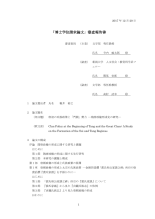8 0 0 0 OA <論説>隋代弘農楊氏の研究 : 隋唐政権形成期の「門閥」
- 著者
- 堀井 裕之
- 雑誌
- 東洋文化研究 (ISSN:13449850)
- 巻号頁・発行日
- no.19, pp.1-30, 2017-03
It is not possible to unravel the nature of the Sui and Tang administrations without addressing the role played by the Han Chinese“ dominant families”(門閥) in the amassing of societal respect by the governing class. However, previous research has not actively discussed the degree to which these “dominant families” played a role in the formation of the Sui and Tang administrations. This paper examines the so-called Yuegongfang(越公房) lineage of the Hongnong Yang clan(弘農楊氏), representative of the Han Chinese “dominant families,” by studying epitaphs(墓誌) and historical documents that have continuously been unearthed in recent years. As a result, this study demonstrates that the Yuegongfang clan maintained clan unity by establishing vast family burial grounds in Huayin(華陰)—the clan’s birthplace—and comprised of a great number of family lineages. In addition, the Yuegongfang, who possessed this foundation in rural society and were the central lineage of the Yang dominant family, shared their surname with the Sui Dynasty’s Imperial House, allowing them to obtain a position corresponding to that of the Imperial Family. In time, they were made part of the Zongwei (宗衛)— the Crown Prince’s guard—thus taking charge of the Imperial House’s military organization. This became the source of the Yuegongfang’s powerful influence, strong enough to affect the Crown Prince’s dethronement. This relationship between the Yuegongfang and the Sui Imperial House can be rephrased as the merging of Han Chinese “dominant families” and the emerging non-Han clans. Here, this paper inquiries anew into the significance of the influence of China’s dominant families in the formation process of the Sui and Tang administrations.
6 0 0 0 OA 唐初の氏族政策と「門閥」勢力 -隋唐政権形成史の研究-
6 0 0 0 IR 隋代弘農楊氏の研究 : 隋唐政権形成期の「門閥」
- 著者
- 堀井 裕之
- 出版者
- 学習院大学東洋文化研究所
- 雑誌
- 東洋文化研究 = Journal of Asian cultures (ISSN:13449850)
- 巻号頁・発行日
- no.19, pp.428-399, 2017-03
It is not possible to unravel the nature of the Sui and Tang administrations without addressing the role played by the Han Chinese" dominant families"(門閥) in the amassing of societal respect by the governing class. However, previous research has not actively discussed the degree to which these "dominant families" played a role in the formation of the Sui and Tang administrations. This paper examines the so-called Yuegongfang(越公房) lineage of the Hongnong Yang clan(弘農楊氏), representative of the Han Chinese "dominant families," by studying epitaphs(墓誌) and historical documents that have continuously been unearthed in recent years. As a result, this study demonstrates that the Yuegongfang clan maintained clan unity by establishing vast family burial grounds in Huayin(華陰)—the clan's birthplace—and comprised of a great number of family lineages. In addition, the Yuegongfang, who possessed this foundation in rural society and were the central lineage of the Yang dominant family, shared their surname with the Sui Dynasty's Imperial House, allowing them to obtain a position corresponding to that of the Imperial Family. In time, they were made part of the Zongwei (宗衛)— the Crown Prince's guard—thus taking charge of the Imperial House's military organization. This became the source of the Yuegongfang's powerful influence, strong enough to affect the Crown Prince's dethronement. This relationship between the Yuegongfang and the Sui Imperial House can be rephrased as the merging of Han Chinese "dominant families" and the emerging non-Han clans. Here, this paper inquiries anew into the significance of the influence of China's dominant families in the formation process of the Sui and Tang administrations.
3 0 0 0 IR 唐初の氏族政策と「門閥」勢力 : 隋唐政権形成史の研究
3 0 0 0 隋代弘農楊氏の研究 : 隋唐政権形成期の「門閥」
- 著者
- 堀井 裕之
- 出版者
- 学習院大学東洋文化研究所
- 雑誌
- 東洋文化研究 = Journal of Asian cultures (ISSN:13449850)
- 巻号頁・発行日
- no.19, pp.428-399, 2017-03
1 0 0 0 IR 唐太宗・高宗期の帝陵陪葬墓の形成と氏族政策の展開 : 太宗昭陵を中心に
- 著者
- 堀井 裕之
- 出版者
- 駿台史学会
- 雑誌
- 駿台史學 = Sundai historical review : the journal of the Historico-Geographical Association of Meiji University (ISSN:05625955)
- 巻号頁・発行日
- no.170, pp.23-53, 2020-09
1 0 0 0 デザイン思考に基づいたイノベーション教育-北米の最新動向-
- 著者
- 岡 瑞起 田村 大 堀井 裕之
- 出版者
- 一般社団法人情報処理学会
- 雑誌
- 情報処理 (ISSN:04478053)
- 巻号頁・発行日
- vol.50, no.12, pp.1222-1227, 2009-12-15
- 被引用文献数
- 1
